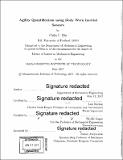Agility quantification using body worn inertial sensors
Author(s)
Eke, Chika U
DownloadFull printable version (7.928Mb)
Other Contributors
Massachusetts Institute of Technology. Department of Mechanical Engineering.
Advisor
Leia Stirling and Neville Hogan.
Terms of use
Metadata
Show full item recordAbstract
Agility is defined as the ability to quickly change speed or direction. Planned agility refers to the physical act of changing direction and reactive agility addresses the additional cognitive responses needed to react quickly to an external cue. This work specifically considers reactive agility. Agility performance is often evaluated using time-based metrics, which provide little information about which factors aid or limit success. Two studies were completed to identify key factors contributing to agility performance. The objective of the first study was to determine how novices and experts working in athletic, clinical, and military environments qualitatively and quantitatively evaluate agility performance. Thirty-three participants completed a survey which involved scoring 16 athletes on a 7 point Likert scale of not agile to agile. The spread of the scores indicated that even within groups, participants had different opinions about which aspects of technique contributed to high performance. Participant responses were used to link several terms to agility technique. The objective of the second study was to apply these terms to the development of objective biomechanical metrics. An array of body-worn inertial sensors was used to calculate metrics that were sensitive to performance speed. Five metrics were defined (normalized number of foot contacts, stride length variance, arm swing variance, mean normalized stride frequency, and number of body rotations). Eighteen participants donned 13 sensors to complete a reactive agility task, which involved navigating a set of cones in response to a vocal cue. Participants were grouped into fast, medium, and slow performance based on their completion time. Participants in the fast group had the smallest number of foot contacts after normalizing by height, highest stride length variance, highest forearm angular velocity variance, and highest stride frequency after normalizing by height.These metric values translate to an efficient strategy for making turns by minimizing path length between cues and cones, effectively adjusting stride in reaction to turn points, and using tight pumping arm motions to aid in accelerating out of endpoint cones.The results of this study have the potential to inform the development of a composite agility score constructed from the list of significant metrics. Study 1 informed the quantification of qualitative agility terminology and Study 2 mapped these terms to speed of performance. The outcomes from these studies can assist in strategy development for training and rehabilitation across athletic, clinical, and military domains.
Description
Thesis: S.M., Massachusetts Institute of Technology, Department of Mechanical Engineering, 2017. Cataloged from PDF version of thesis. Includes bibliographical references (pages 80-82).
Date issued
2017Department
Massachusetts Institute of Technology. Department of Mechanical EngineeringPublisher
Massachusetts Institute of Technology
Keywords
Mechanical Engineering.